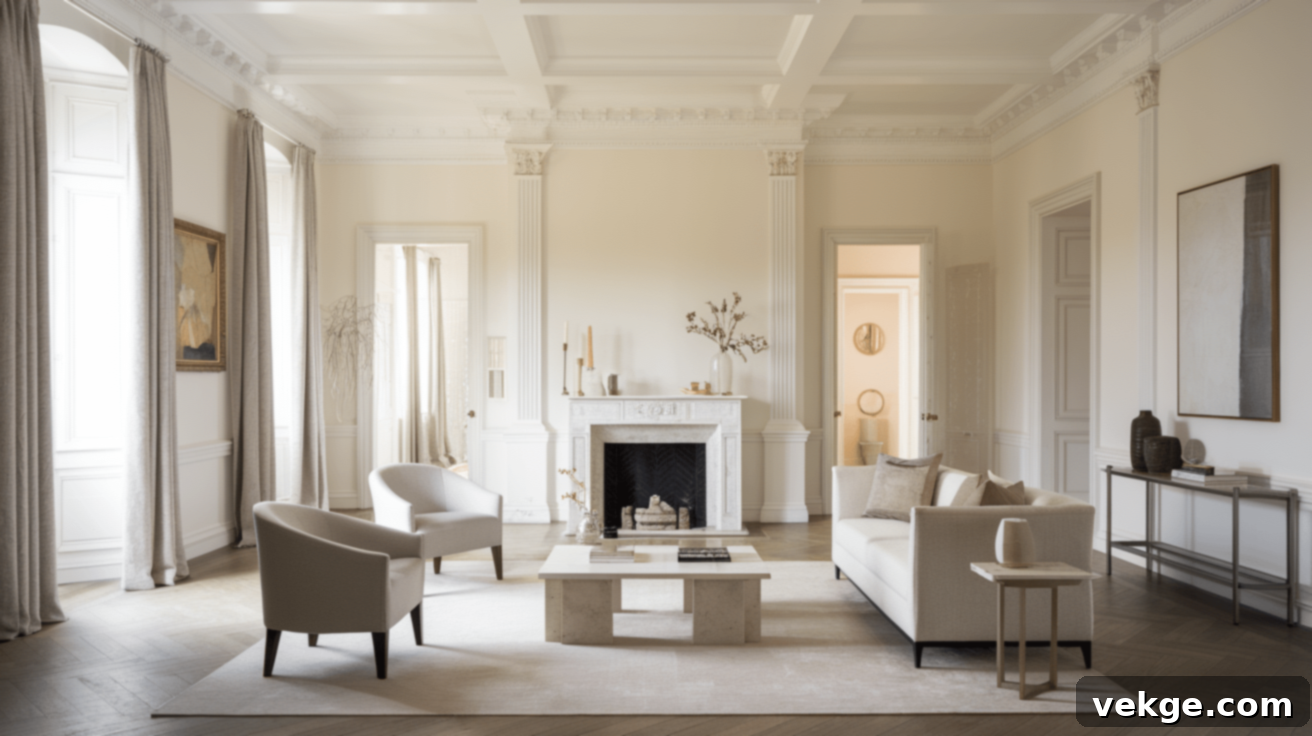The Ultimate Guide to Neoclassical Design: Crafting Timeless Interiors
Neoclassical design is a celebration of enduring beauty, drawing its inspiration from the majestic architectural marvels of ancient Greece and Rome. This sophisticated style introduces an air of refined elegance and understated grandeur into any space, distinguished by its simple forms, balanced compositions, and remarkably clean aesthetics.
Its principles are as relevant today as they were centuries ago, which is why neoclassical elements continue to grace modern homes. The inherent focus on balance, order, and a restrained beauty creates environments that exude a profound sense of calm and effortless cohesion. People are drawn to these spaces because they manage to feel both stately and intimately comfortable simultaneously.
The genius of neoclassical design lies in its seamless blend of historical reverence with contemporary living requirements. It harmonizes perfectly with modern lifestyles while preserving that unique, timeless character that has captivated hearts for hundreds of years. This comprehensive guide will walk you through every aspect of creating a stunning neoclassical interior, from foundational principles to the finest decorative details. Let’s embark on this journey to timeless elegance!
The Enduring Principles of Neoclassical Design
At its core, neoclassical design is built upon a set of foundational principles that imbue spaces with its signature character. Understanding these elements is crucial for authentically translating the style into your home.
Symmetry and Balance
The hallmark of neoclassical design is its unwavering commitment to symmetry. Imagine a perfectly balanced visual scale where equal parts are distributed on both sides of a central axis within a room. This often means arranging furniture, artwork, and architectural details in a mirrored fashion. For instance, a pair of matching armchairs flanking a fireplace, or twin lamps positioned on either end of a console table, create this deliberate sense of equilibrium. This precise balance isn’t just about aesthetics; it profoundly affects how a space feels, instilling a deep sense of order, peace, and understated grandeur that immediately puts occupants at ease.
Clean Lines and Simple Forms
In stark contrast to the elaborate ornamentation of Baroque or Rococo styles, neoclassical design champions simplicity. It favors basic geometric shapes and clear, straight lines. Furniture often features strong, architectural silhouettes with minimal curves, and architectural details maintain a crisp, unfussy appearance. This adherence to clean lines prevents rooms from feeling cluttered, allowing the eye to flow effortlessly through the space. The result is an open, airy atmosphere that feels spacious and uncluttered, making rooms appear larger and more inviting.
Subdued Color Palette
The color scheme in neoclassical interiors is intentionally restrained, acting as a serene backdrop for the sophisticated forms and textures within the space. The foundation typically consists of a palette of whites, creams, soft grays, and pale blues or greens. These muted, natural tones create an atmosphere of tranquility and refinement, reflecting natural light beautifully. This calm base provides the perfect canvas for subtle accents of richer, deeper colors, often inspired by precious stones—think deep blues, emerald greens, or warm golds—applied sparingly in textiles or decorative objects, adding depth without overwhelming the serene environment.
Incorporating Classical Elements with Modern Sensibility
Neoclassical spaces ingeniously reinterpret classical Greek and Roman motifs, adapting them for contemporary living without appearing overtly theatrical or dated. This might manifest as simplified fluted columns framing a doorway, elegant archways that define transitions between rooms, or subtle frieze patterns integrated into molding. These elements are not extravagant reproductions but rather refined suggestions of classical grandeur, adding a layer of historical depth and sophistication that elevates the overall design.
High-Quality Materials
Authenticity and longevity are key in neoclassical design, which is why a strong emphasis is placed on natural, high-quality materials. Luxurious marble, honed stone, rich dark woods like mahogany or walnut, and fine fabrics such as silk, linen, and wool are frequently utilized. These materials not only look exquisite but also possess inherent durability and often improve with age, acquiring a beautiful patina over time. Their substantial nature contributes to the timeless and opulent feel of neoclassical spaces, reflecting craftsmanship and enduring value.
Your Step-by-Step Guide to Neoclassical Design
Transforming your home into a neoclassical sanctuary involves a thoughtful, methodical approach. Follow these steps to build your elegant interior layer by layer.
Step 1: Establishing the Layout and Focal Points
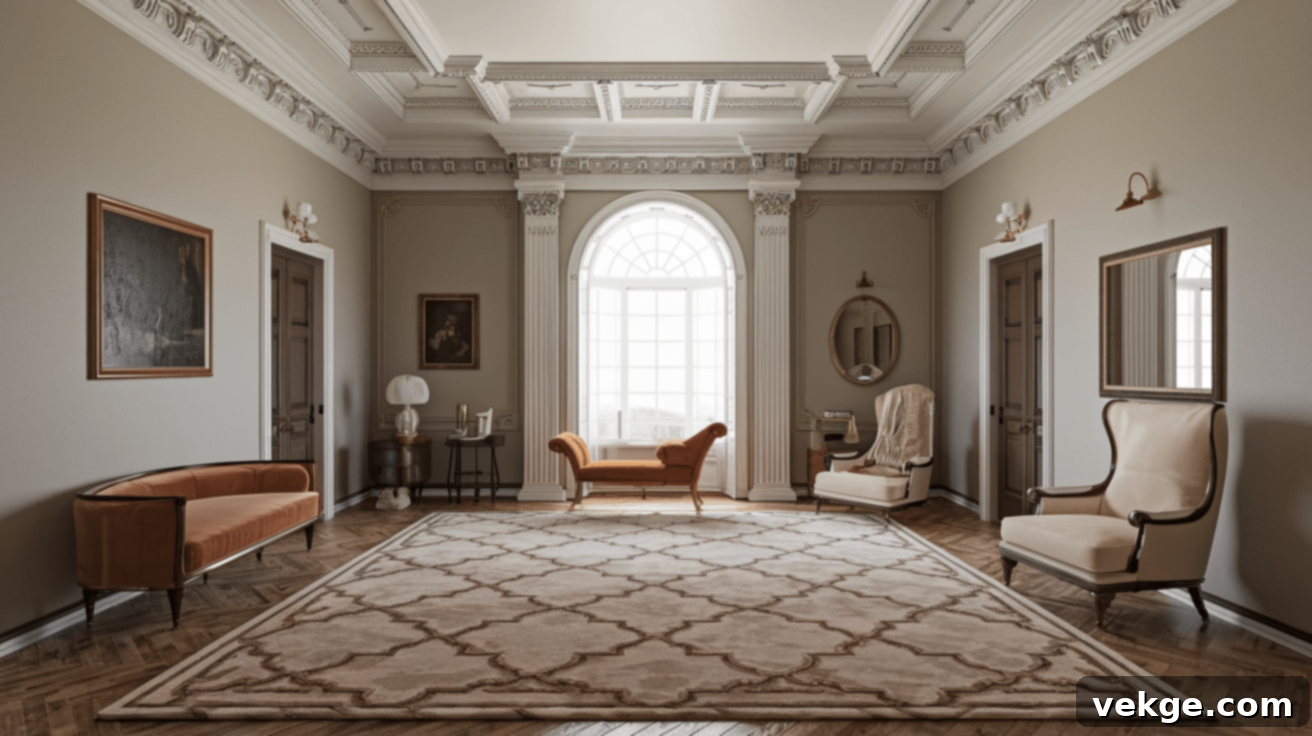
Mastering Room Symmetry
The journey to a neoclassical space begins with a meticulously planned, balanced room layout. Start by measuring your room accurately and identifying its natural or chosen center point. Position your primary furniture pieces so they create a mirrored effect on either side of this central axis. For instance, flank a prominent sofa with two identical armchairs, or place two matching table lamps at opposite ends of a long console table. Maintain consistent spacing between furniture pieces to reinforce the sense of order. If a window occupies one wall, consider balancing it with a proportionally sized mirror or a large piece of art on the opposing wall. This symmetrical arrangement is fundamental, creating a foundation that feels organized, serene, and inherently neoclassical.
Defining Focal Points
Every neoclassical room benefits from a clear focal point – a central feature that naturally draws the eye and anchors the space. In a living room, a grand fireplace often serves this purpose beautifully; position it centrally on a wall and arrange your primary seating to face it. For dining areas, a substantial dining table complemented by an elegantly designed chandelier above creates an undeniable center of attention. Artwork can also function as a powerful focal point; select a generously sized piece for the main wall and hang it at eye level. Ensure the surrounding area is kept simple to allow the chosen piece to truly stand out. These well-defined focal points provide direction and purpose, making the room feel thoughtfully composed and complete.
Step 2: Selecting and Arranging Neoclassical Furniture
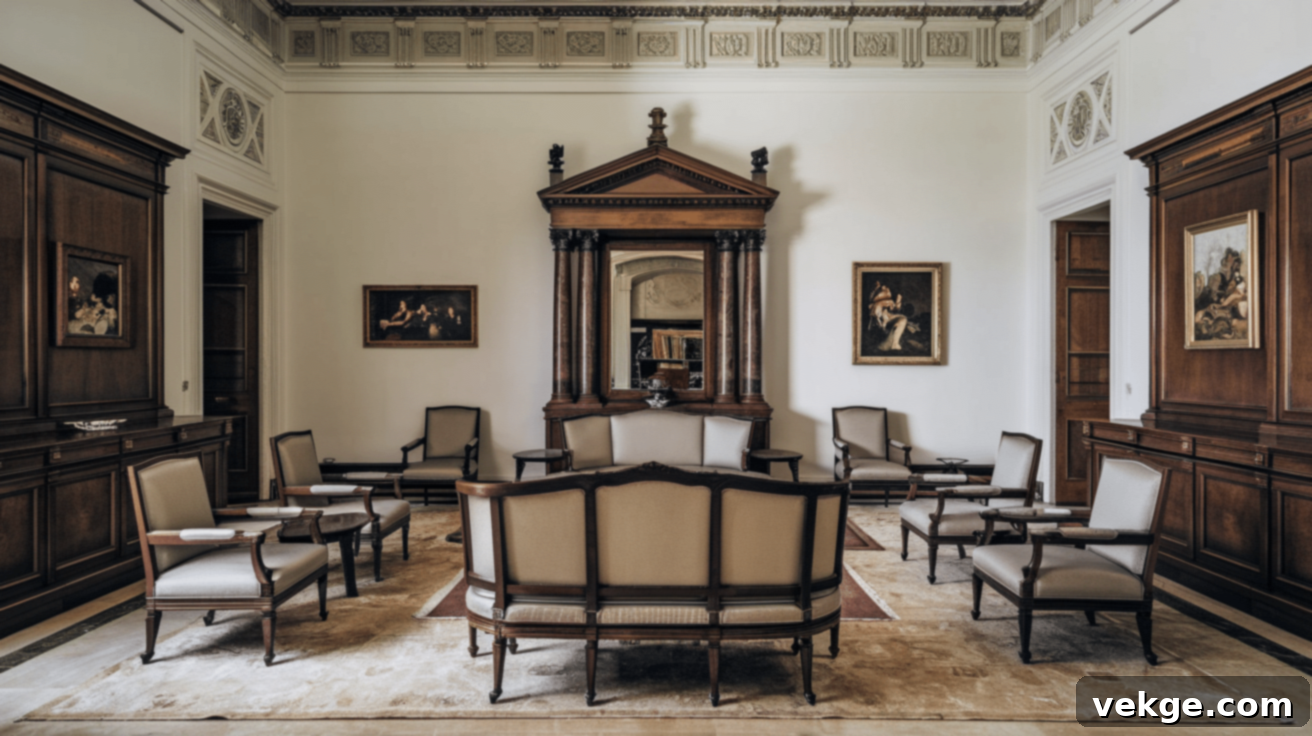
Embracing Timeless and Elegant Pieces
To achieve an authentic neoclassical aesthetic, prioritize furniture with clean, architectural lines and simple, geometric forms. Look for sofas and chairs featuring firm, square backs and tailored arms, eschewing overly plush or rounded designs. Tables should ideally have straight, often tapered, legs rather than ornate or curved ones. Darker wood finishes, such as rich walnut, mahogany, or cherry, are highly characteristic of this style, conveying sophistication and warmth. Seek out pieces that incorporate subtle classical details, such as fluted legs (featuring vertical grooves), delicate reeding, or simple, understated carvings. These refined touches add historical authenticity without being excessively decorative. Emphasize quality over quantity; a few well-crafted, enduring pieces will contribute far more to the neoclassical ambiance than numerous lower-quality items, promising beauty that lasts for decades.
Strategic Furniture Arrangement
Arrange your chosen furniture with a keen eye for balance and symmetry. If an armchair is placed to one side of your sofa, ensure a corresponding piece—either an identical armchair or one of similar visual weight—is positioned on the opposite side. While not every item needs a twin, the overall visual weight distribution across the room should feel even and harmonious. Crucially, allow some breathing room between furniture pieces and walls; a small gap creates an illusion of openness and highlights the distinct form of each item. Orient seating arrangements towards the room’s central focal point or inward, fostering an environment conducive to conversation and social interaction. Always ensure clear, unobstructed walking paths of at least three feet wide, combining aesthetic appeal with essential functionality.
Step 3: Integrating Neoclassical Architectural Features
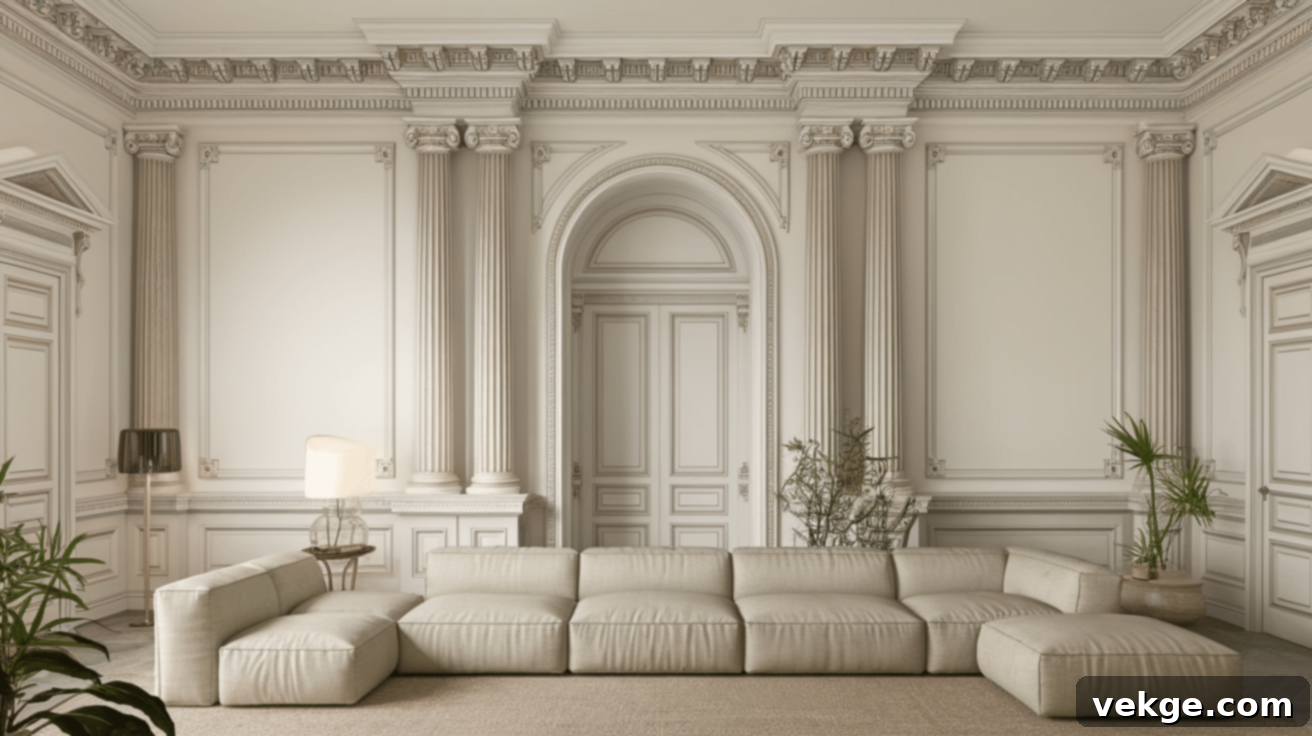
Columns and Pillars
Columns are quintessential neoclassical elements that can infuse a classic touch without overwhelming a modern space. Rather than imposing full-scale stone pillars, consider more subtle applications: slim, often wooden, columns can artfully define transitions between living and dining areas. Half-columns or pilasters affixed against a wall beside a doorway or fireplace offer a similar architectural statement with less structural intervention. For a truly minimalist approach, select furniture pieces that subtly echo column forms in their legs or supports, such as a bed frame or cabinet with fluted detailing. The key is judicious use, allowing these features to act as distinctive, refined accents within your design.
Archways and Doorways
Soft, graceful archways inherently promote a smooth, flowing transition between rooms, enhancing the spaciousness of an interior. If a structural renovation is feasible, a contractor can transform a standard rectangular doorway into an elegant arch, creating a significant impact. For less intensive changes, consider incorporating arched mirrors or pieces of artwork that mimic the form of an arch. Strategically placed above straight doorways, these elements can beautifully hint at classical design. Additionally, freestanding room dividers or bookcases with arched tops can introduce this distinct architectural motif without altering the existing structure, bringing classical charm into your living space.
Moldings and Paneling
Architectural moldings are fundamental to neoclassical style, adding depth and definition to otherwise plain walls. Crown molding, installed where walls meet the ceiling, instantly elevates a room, making it appear taller and more finished. Opt for simple, crisp white profiles for a clean, classic look. To further enhance the walls, introduce a chair rail molding approximately three feet from the floor, creating a subtle division. For an even more impactful transformation, apply wall panels, crafted from wood or high-quality foam, to create rectangular boxes or geometric patterns on your walls. Painting these panels the same color as the wall creates a subtle, textural effect, while a slightly different shade or finish can make them a more prominent feature. These details transform flat surfaces into visually engaging architectural elements.
Step 4: Incorporating the Right Colors and Textures
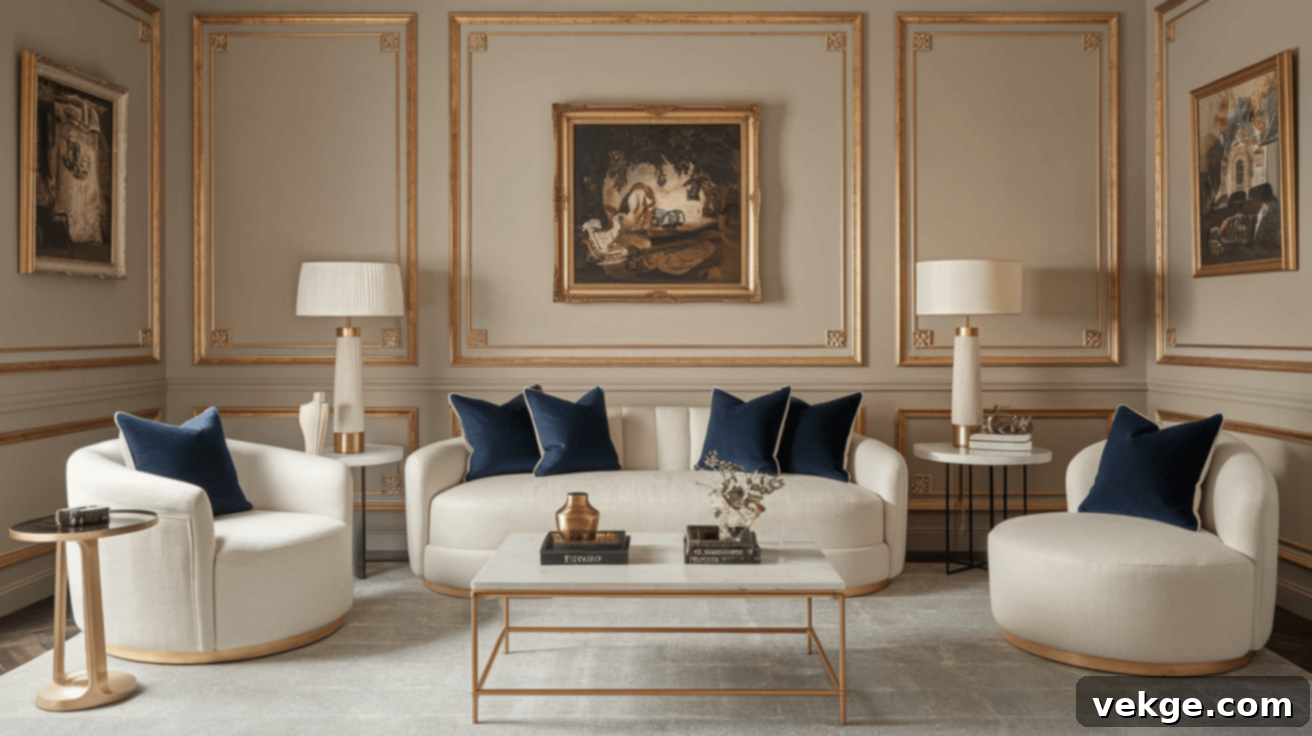
Establishing a Neutral Base Color Palette
Begin with a serene foundation of light, calm colors for your walls and larger furnishings. Whites, creams, and soft grays are the bedrock of neoclassical design, creating an expansive and peaceful atmosphere. These colors act as a clean, sophisticated canvas, allowing other elements of your room—such as furniture forms or accent details—to truly shine. Consider shades like cool ivory, subtle pale gray, or classic off-white for walls; these versatile hues harmonize effortlessly with virtually any accent color you might introduce. Moreover, light base colors amplify natural light, contributing to a brighter and more open feel within the space.
Strategic Accents of Jewel Tones or Metallics
Once your soothing base colors are established, introduce small, deliberate touches of richer hues to add depth and interest. Deep blues, muted greens, or warm golds are exemplary choices for neoclassical accents, bringing a sophisticated vibrancy without overpowering the room’s serene character. Incorporate these richer tones through smaller decorative items such as throw pillows, luxurious throws, or select pieces of art. A striking dark blue vase on a pristine white mantelpiece or elegant gold picture frames adorning a cream-colored wall can create beautiful visual anchors. Remember to keep these color interventions minimal and strategically distributed throughout the room to maintain balance and avoid visual clutter.
Layering Textures for Depth
Textures are vital for adding richness and tactile interest, even within a simple color scheme. The art lies in blending smooth and soft surfaces to create a dynamic sensory experience. For example, pair a lustrous silk pillow with a rustic linen chair cushion, or a sleek, polished wooden table with a soft, textured fabric runner. For window treatments, opt for natural materials like crisp cotton or flowing linen curtains that gently filter natural light while providing a touch of privacy. To add warmth and an inviting feel underfoot, select a wool rug featuring a subtle, classic pattern. These deliberate textural contrasts transform a plain room into a multi-dimensional space, inviting interaction and making it feel complete and thoughtfully designed.
Step 5: Thoughtful Lighting in Your Neoclassical Space

Maximizing Natural Light
Embrace and optimize every source of natural light in your neoclassical room. Keep window coverings minimal and designed to open fully during daylight hours. Sheer, light-colored curtains made from linen or cotton are ideal, allowing ample sunshine to flood the interior while offering a delicate veil of privacy. Strategically place mirrors directly opposite windows; this brilliant trick bounces light deeper into the room, making the space feel significantly larger and brighter. If possible, prune any exterior foliage that might be obstructing window views. Maximizing natural light is paramount, as it beautifully highlights the clean lines, simple forms, and subtle textures that define neoclassical elegance.
Selecting Statement Lighting Fixtures
Choose one central, impactful lighting fixture that is appropriately scaled for your room. In dining areas, a classic chandelier, typically hung about 30 inches above the table, serves as a magnificent focal point. For living rooms, seek out fixtures characterized by clean lines and a hint of polished brilliance—materials like clear glass, crystal, or polished metals (such as brass or chrome) are excellent choices. These elements add a touch of refined glamour without appearing ostentatious. Ensure your chosen main light fixture is proportionate to the room’s dimensions; an oversized fixture can dominate, while one too small will get lost in the space.
Layering Light for Ambiance and Function
Never rely on a single light source. Instead, implement a layered lighting scheme to provide both functional illumination and adjustable ambiance. Incorporate elegant table lamps on side tables or a desk for targeted task lighting, perfect for reading or focused work. Wall sconces, positioned at eye level, emit a soft, diffused glow that can make rooms feel incredibly cozy and intimate in the evenings. Utilize small accent lights to highlight specific architectural features, artwork, or decorative columns. This strategic mix of ambient, task, and accent lighting, positioned at varying heights, allows you to effortlessly control the room’s mood and functionality. Opt for warm-toned bulbs (soft white) to maintain an inviting and welcoming atmosphere throughout your neoclassical interior.
Step 6: Thoughtful Decorative Accessories
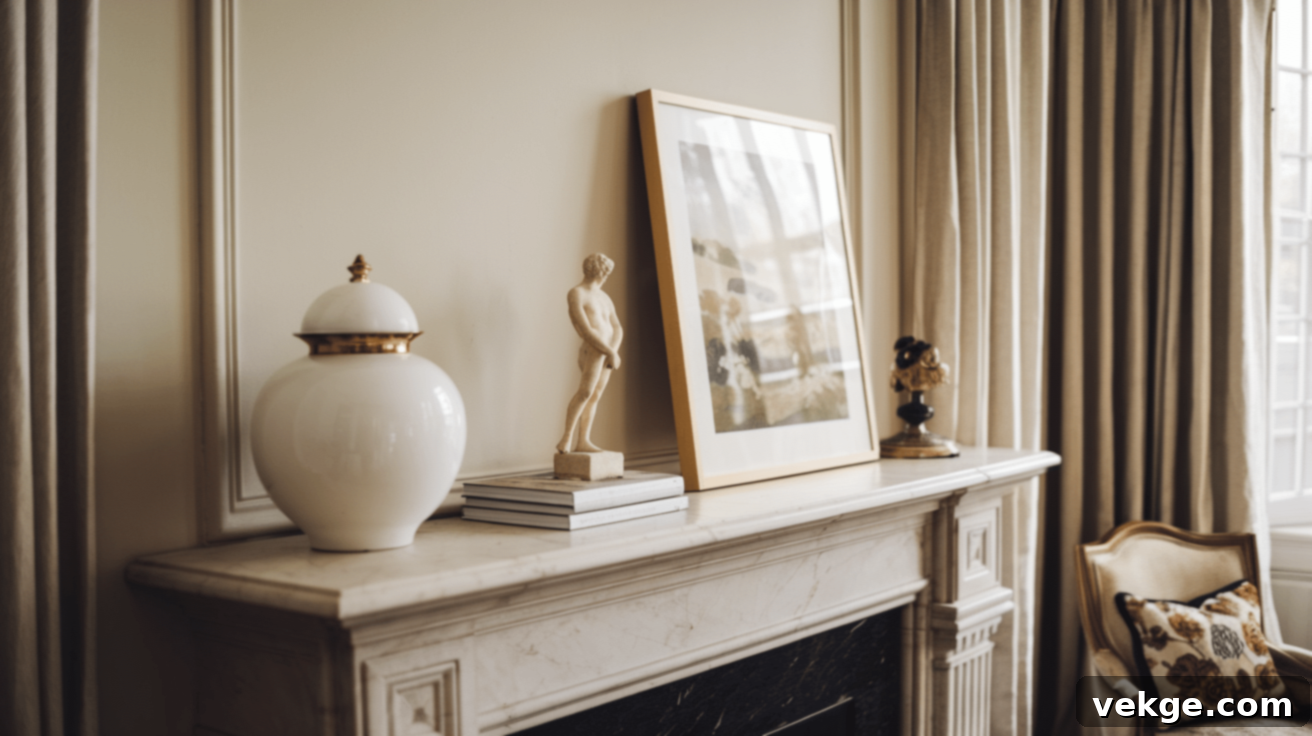
Embracing a Minimalist Approach to Decor
In neoclassical design, restraint is key when it comes to decorative accessories; less truly is more. Select only a few cherished, high-quality pieces that hold personal significance or possess inherent beauty. A single exquisite vase, a classic bust or small statue, or framed artwork depicting serene landscapes or classical motifs can be incredibly impactful. Arrange these items thoughtfully, often in balanced groupings of three, on surfaces such as mantels, coffee tables, or bookshelves. Crucially, leave ample empty space around your chosen accessories to allow each piece to breathe and command attention. Art selections should be refined and calming—landscapes, still life compositions, or black-and-white photography in simple, understated frames perfectly complement the style, adding sophistication without creating visual noise. Choose pieces that evoke a sense of tranquility and contemplation.
Harmonizing Textiles and Rugs
Textiles introduce essential comfort and softness to the crisp lines of neoclassical rooms. For rugs, select designs with subtle patterns, such as a traditional Greek key border, classic stripes, or a plain texture, in colors that resonate with your wall and furniture palette. These should complement rather than compete with the room’s overall aesthetic. For throw pillows and blankets, opt for solid colors or very small, refined patterns. Soft blues, muted greens, or warm gold tones work beautifully against light wall colors, adding gentle warmth and visual interest. Ensure there’s a cohesive thread—either through color family, pattern scale, or texture—that links your chosen textiles. Window treatments should also maintain simplicity: full-length, plain panels in fabrics like cotton, linen, or light silk are ideal, as they hang elegantly and contribute to the clean, classic look. These textile elements soften the architectural rigor of the room, making it feel inviting, cozy, and truly lived-in while preserving its inherent classic charm.
Step 7: Blending Neoclassical with Modern Elements
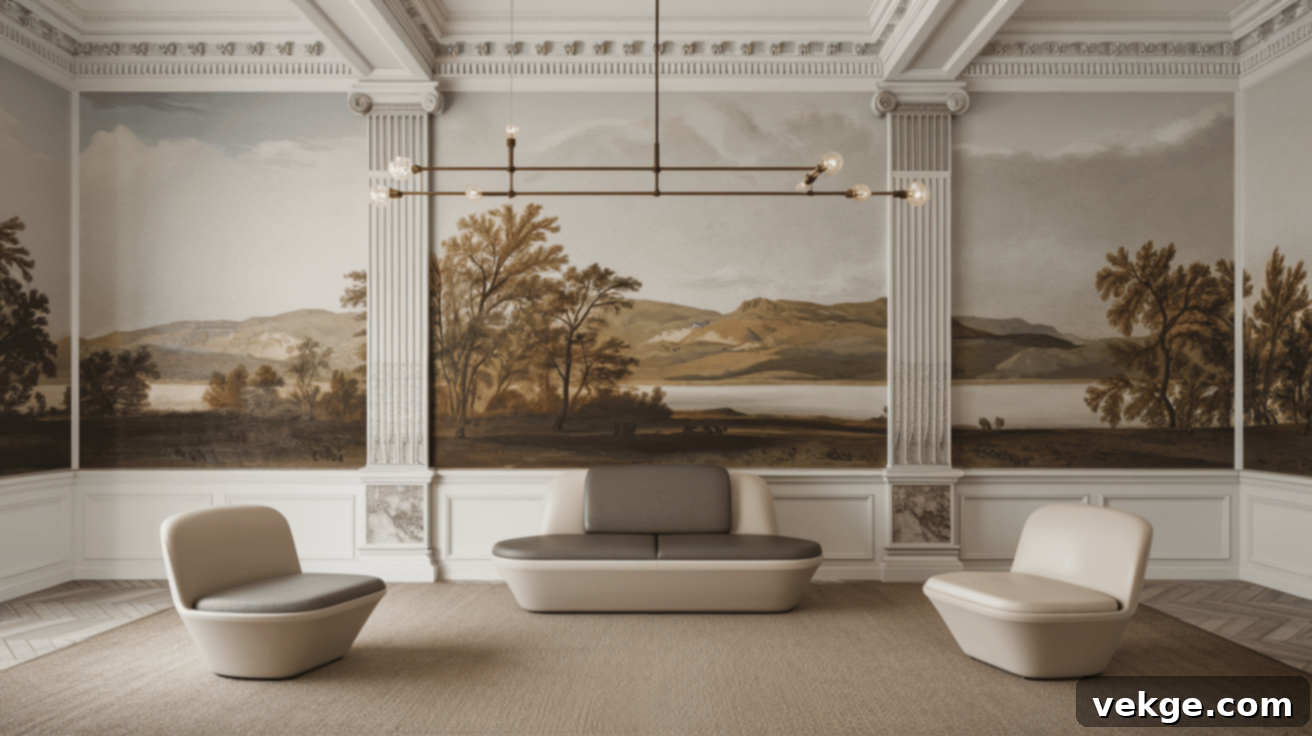
Integrating Contemporary Updates
The beauty of neoclassical design lies in its adaptability, allowing for a harmonious blend with modern elements to create a fresh, dynamic space. Picture a sleek, clean-lined sofa in a neutral tone positioned against a wall adorned with traditional crown molding; this juxtaposition artfully highlights the best of both styles. Modern lighting fixtures, characterized by their simple forms and unadorned aesthetics, can seamlessly integrate into a classical room. A minimalist glass pendant light or a slim, architectural floor lamp introduces a contemporary edge without clashing with the room’s timeless foundation. The secret lies in selecting modern pieces that echo the neoclassical emphasis on clean lines and essential forms, avoiding overly intricate or trendy designs. For artwork, bold black and white photographs or abstract prints in simple frames can provide a striking modern contrast to classic architectural features, bridging eras with sophisticated ease.
Functionality Meets Style in Modern Neoclassical Living
Contemporary homes demand functionality without sacrificing style. To discreetly integrate technology, consider concealing televisions within custom cabinetry with elegant doors, or mounting flat screens on walls painted a complementary dark shade to help them recede visually. Small, wirelessly connected speakers can be tucked away on shelves, minimizing their presence. For home office spaces, choose desks with straight lines and understated hardware, positioning them near windows to maximize natural light. A wooden desk with a glass top, for example, beautifully marries traditional materials with modern transparency. In kitchens, ensure appliances maintain a consistent color palette—all stainless steel, all white, or all black—to create a unified and streamlined look. Simple cabinet fronts paired with minimal, plain handles contribute to the clean, uncluttered aesthetic that makes neoclassical design so enduringly appealing and practical for modern living.
Mistakes to Avoid When Designing Neoclassical Style
While neoclassical design offers an undeniable path to timeless elegance, certain common pitfalls can inadvertently dilute its sophisticated charm. Being aware of these missteps will guide you toward creating a more authentic, harmonious, and truly magnificent neoclassical interior.
Overcrowding the Space
One of the most significant errors in neoclassical design is filling the room with too many items. This style inherently relies on open space and visual clarity to allow its clean lines, symmetrical arrangements, and quality pieces to truly shine. Resist the temptation to over-furnish; limit your selections to only essential and highly functional pieces. Ensure clear circulation paths of at least three feet between furniture items. Similarly, allow for generous expanses of empty wall space rather than hanging art on every available surface. This deliberate ‘breathing room’ is crucial, enabling the eye to rest and appreciate the beauty of each element and the overall room composition. Remember, in neoclassical aesthetics, the negative space is just as impactful as the objects within it.
Excessive Ornate Detail
While classical styles include some decorative flourishes, an overabundance of ornate details can quickly transform a neoclassical room from elegant to overly formal, even stifling or museum-like. The essence of neoclassical is a *restrained* use of classical motifs. The key is to strike a balance by pairing plainer items with pieces that feature more intricate detailing. For example, if you have a sofa with delicately carved wooden trim, balance it with a simple, unadorned coffee table. Exercise caution with patterns; if your walls feature patterned wallpaper, opt for solid-colored or very subtly textured rugs and upholstery. The goal is to hint at classical grandeur through carefully chosen details, allowing them to accent the clean lines rather than overwhelm them, preserving an air of understated sophistication.
Ignoring Practicality and Comfort
A common mistake is prioritizing aesthetic appeal to the detriment of real-world functionality and comfort. A neoclassical space, despite its formality, must remain a livable and inviting home. Before purchasing, thoroughly test chairs and sofas to ensure they are genuinely comfortable, not merely visually appealing. Reflect on how each room will be used in your daily life. Incorporate practical elements like side tables within easy reach of seating for drinks or books. Thoughtfully integrate storage solutions—such as elegant cabinets or ottomans with hidden compartments—to discreetly tuck away everyday items. Ensure adequate and appropriate lighting for various activities, from bright task lighting for reading to softer ambient light for relaxation. A well-designed neoclassical room can and should comfortably accommodate modern life, including remote controls, phone chargers, and even children’s toys, through smart, integrated storage solutions that maintain the room’s pristine aesthetic when not in use.
Conclusion
Creating a neoclassical space is an artful journey, beginning with a deep appreciation for balance, order, and clean, sophisticated design. Start by establishing a symmetrical and functional layout, then select furniture characterized by its straight lines and understated elegance. Infuse your interior with subtle classical touches through architectural elements like refined columns, graceful archways, or intricate moldings. Build your color scheme on a foundation of light, calming neutrals, punctuating them with thoughtful, restrained accents of richer jewel tones or metallics. Introduce depth and sensory interest by layering diverse textures. Finally, master your lighting, combining abundant natural light with a variety of layered fixtures to create both function and captivating mood. Choose your decorative accessories with a minimalist approach, allowing each selected piece to shine.
The profound beauty of neoclassical design lies in its remarkable ability to blend historical reverence with modern functionality, crafting rooms that feel both uniquely special and wonderfully comfortable. It’s a style that transcends fleeting trends, offering an enduring aesthetic that will grace your home for years to come.
What aspects of neoclassical design resonate most with your personal style? Share your thoughts and inspirations in the comments below!
